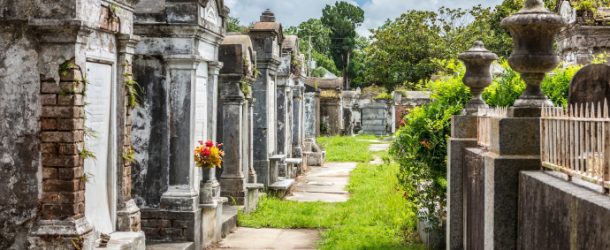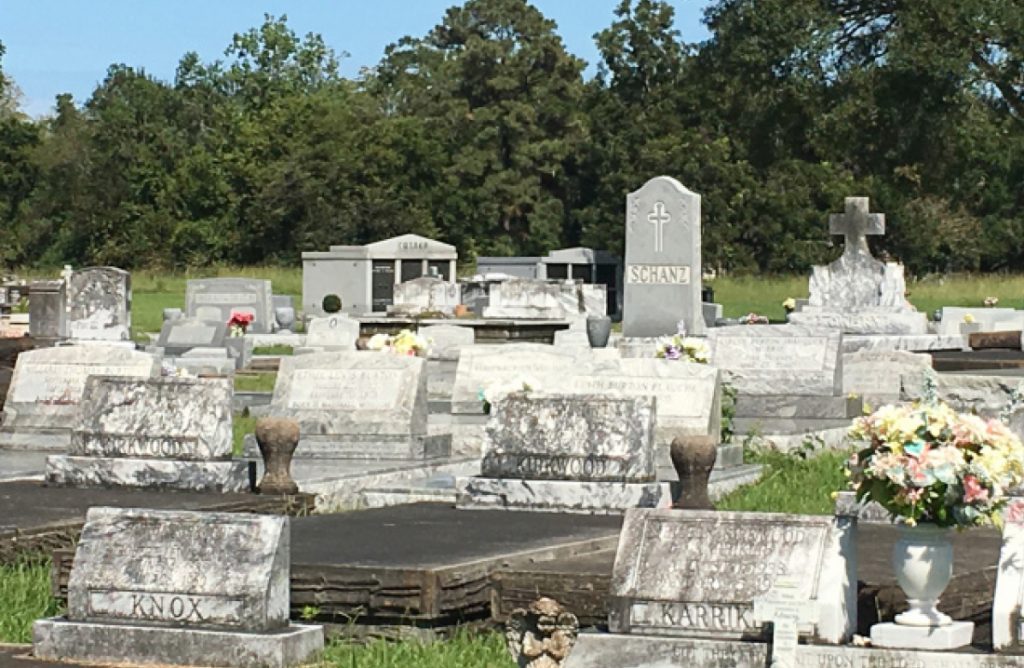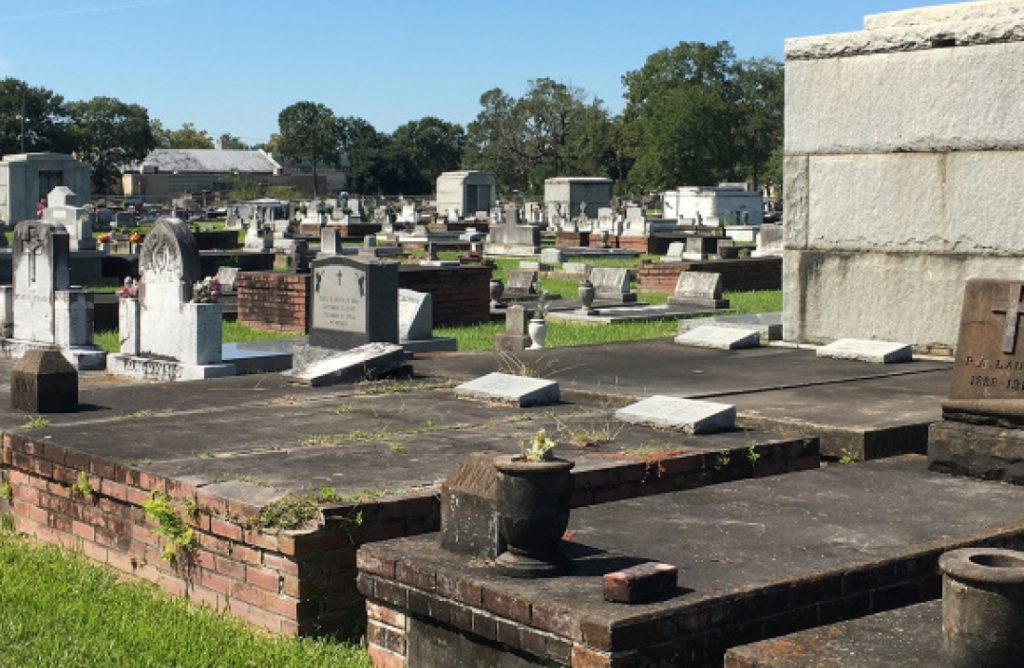By Madelaine B. Landry
“What could you possibly hope to find in a cemetery?” The women said. “The dead tell no secrets and the living seldom come to visit them.”
—- Felix Alexander, The Last Valentine
Every culture and religion has its beliefs and norms — guidelines for how its adherents reflect upon life and death, past and future. Most demonstrate very detailed traditions about how the deceased are to be treated with respect and reverence. Rituals to celebrate lives after death are common, especially for the comfort they bring to those left behind. Many religions seek to reduce the sting of death with expressions of hope for another life beyond this earthly one.
Bodies are lovingly prepared for this journey before being cremated, burned on pyres, released to the sea or buried. Bodies or ashes are placed into some sort of container, in mounds or into a mausoleum. The memorials we build are how we let our loved ones “live on” into the future.
Necrogeography, the cultural study of funeral and burial practices, focuses on how various cultures exhibit their respect for not only their dead, but also for the graves in which their remains lie. American cemeteries, where multiple graves share common ground, have evolved through the centuries from colonial times to the present. From small family plots to church yards to town commons to memorial gardens, they are considered sacred places — cities of the dead. The living value them as places that contain the final resting sites of loved ones. People gather there to converse, pray and remember.
Others value the historic or family information that can be gleaned from the tombstones. Visiting graves is a tradition that continues generation after generation, long after those who are interred have ceased to exist in living memory.
The evolution of cemeteries has a complex and fascinating history.
Picture the elaborate entrance gates to late 19th and early 20th century cemeteries. They were ornate iron structures, designed to place a distinct boundary that separates the world of the living from the realm of the spirits.
A variety of emotions is experienced upon entry, ranging from curiosity, fright, grief, captivation or repulsion. Whoever is buried beyond those gates once walked this earthly realm. It is understood, on some level, that someday, we too will cease our walking and inhabit a space in such a place. Inscriptions are read. Weeping angels capture the imagination. Historic curiosity is whetted. Our own mortality is confronted.
“Burial isn’t just about celebrating the dead,” noted Keith Eggener, an associate professor of American art and architecture at the University of Missouri, in his 2010 book Cemeteries. “It’s about containing the dead —keeping them out of the realm of the living, which is why cemeteries were removed from cities. We would like to go into their world [only] when it’s convenient for us.”
Eggener describes cemeteries as gridded cities for the dead, ornately designed with meandering pathways, horticultural displays and exquisite statuary. Once, they attracted Americans as more than just a place to meditate upon mortality or experience spirituality. He reminds his readers of a time in our history, before public parks, art museums or botanical gardens were developed, when cemeteries were also places for recreation. As odd as that sounds to the modern ear, visitors would often wind their way among the headstones for picnics, hunting, shooting and even carriage racing.
“These places became so popular that not only were guidebooks issued to guide visitors, but also all kinds of rules were posted,” notes Eggener.
Louisiana, with its predominantly Catholic culture, has always been unique for the way its festive activities occurred within its cemeteries. In southern Louisiana, especially in New Orleans, a city built below sea level, above-ground tombs became a necessity because burials in relatively deep graves would result in flooding and the deterioration of the casket and remains. In North Louisiana, higher ground and deeper water tables meant below-ground burials were more common.
With its French, Spanish, Irish, German and other European influences, religion defined many of the customs passed down throughout the state’s geographic locations. Add to this mix Native American, African, Creole and Caribbean Island cultures, and it’s easy to see why necrogeography becomes a mesmerizing, mysterious, and multifaceted study.
The liturgical Catholic church calendar counts All Saints Day among its holy days of obligation. It is observed annually on Nov. 1. It was once an important tradition for families to gather in cemeteries to clean and decorate the graves of loved ones. Picnics could be day-long affairs, with family and friends visiting one another. Nearby, vendors sold food and flowers. It was an important way for families to share ancestral stories, keeping memories of the deceased alive, and helping each generation to understand from which branch it grew on the family tree.
Many Protestant religions had similar rituals for grave cleaning and maintenance of the grounds surrounding graves. In a 2016 blog entry at 64parishes.org, historian Ryan Brasseaux speaks about some of the Louisiana grave-cleaning traditions.
“In the past, families repaired tombs and coated them with a mix of lime and water (whitewash) to seal the structure. They also cleared overgrowth and weeds and placed floral arrangements, or ‘coronne de toussaints,’ on the graves to show their respect for the dead. In years past, women would make wreaths of crepe paper or waxed paper, known as immortelles or couronnes, and sell them at churches and cemeteries on All Saints Day. But that tradition waned as more durable plastic flowers came into vogue. In less-affluent communities, families simply painted wooden crosses to use as grave markers.
“Participation in this tradition has waned in many places,” notes Brasseaux, “but remains significant in the St. Tammany Parish community of Lacombe, where French, Creole and Choctaw cultures have influenced the custom. Even some Protestant families have adopted the tradition there.”
Another curiously rare Cajun tradition can be found in Morse in the Istre Cemetery. Grave houses, of which three remain relatively intact, can be found there. Originally, about 40 of these miniature houses existed. They were built to resemble small, gable-roofed houses, complete with siding, windows and hinged doors. They are not to be confused with a grave shelter, which is a Protestant tradition, where the graves are covered by a roof held up by four posts.
Grave houses were built by Cajun Catholic settlers in the Acadiana prairie region. No one is sure how the tradition started, many theories abound. Perhaps they were a form of protection from animals and weather. Perhaps they were a way of ensuring loved ones had a new home in the next life. They are worth the trip to see them; for additional information, visit onlyinyourstate.com/louisiana/istre-cemetery-la.
The Mexican culture, also an integral part of Louisiana’s past and present, celebrates Día de los Muertos Nov. 1 and 2. The Day of the Dead is a joyful celebration that involves everyone joining in to pay respects to their dearly departed. Celebrations include the telling of funny anecdotes about the departed. Home altars, “ofrendas,” are gaily decorated with marigolds and other flowers, as well as the favorite beverages and foods of those who have passed to the “other side.”
From Church Burial Grounds To Memorial Gardens
In Eggener’s book, he explains that cemeteries, as we know them today, first emerged in the 1830s, with the American rural cemetery movement. We had always buried our loved ones, whether in churchyards, town commons or municipal burial grounds. He explains the evolution of the modern cemetery from the colonial past in America to the present:
“The old church burial grounds were beginning to be seen as inadequate, dangerous, crowded, expensive to maintain and carriers of disease. Thousands of burials had taken place on very small plots of ground; these places filled up. You often had burials five or six coffins deep. Sometimes the walls would break down during floods — coffins would break open and bodies would spill out into the street. During times of epidemics — yellow fever, cholera — cemeteries were seen as centers for the gathering of these diseases and their dissemination.”
Further, as America’s economy grew, cities became more crowded. Real estate prices rose. American cemeteries became the last “great necessity” in a list of desired amenities.
“By moving the dead out of the city center to places like Brooklyn and Cambridge, these ‘rural cemeteries’ allowed for much larger burial grounds that also removed the dead from the immediate realm of the living,” notes Eggener.
How each culture deals with putting their loved ones to rest depends not only on geography, but also on its distinctive behavioral patterns. Part of the grieving process is in the laying to rest. In our geographic region, however, Mother Nature often interferes. For anyone who’s experienced this, it can feel as if someone has been lost again.
A Louisiana Story: Repair, Restoration And Relocation Of Graves
Louisiana has a long history of catastrophic storm events. Hurricanes spawn dangerous storm surges — water pushed toward the shore by the force of winds blowing up to 155 mph in a Category 4 event.
Coastal residents know this full well: water is never just water. It contains sewage, toxic waste and other contaminants. It may also bring in large quantities of salt that will damage grave stones and kill surrounding vegetation.
Surges and forceful winds can transport anything, including metal awnings, pieces of buildings and boats, into every nook and cranny of a community; cemeteries are not spared.
Sand becomes a high-velocity eraser, scouring gravestones, obscuring their information. Trees topple, crushing monuments, destroying signage, and inflicting incredible damage.
The force of even a Category 1 hurricane can dislodge graves and blow or float them miles from their original sites. For families who discover that the final resting place of a loved one has been destroyed, this only adds to the devastation.
Assessment, stabilization, repair and recovery of cemeteries has necessitated the formation of the Cemetery Recovery Task Force through Louisiana Revised Statutes 29:726.4 – A: “The Statewide Cemetery Response Task Force is hereby established to assess response and recovery needs related to cemeteries during any emergency declaration.”
Louisiana Assistant Attorney General Ryan Seidemann is the current director of Louisiana’s task force. According to his office, the destruction at cemeteries left by Hurricanes Laura and Delta was at least as large as that of Katrina and Rita combined.
The latest toll was taken on cemeteries and graves during Hurricane Ida in August, 2021. Although, as one official noted, the tombs may weigh a couple of tons, water and wind can disrupt them just as if they’re made of cardboard. Storms, floods, high winds, and the region’s cultural burial practices that often lay the dead to rest above ground are all contributors to this ongoing problem.
In an October, 2021, NBC news report, Seiderman noted: “They float. They tend to go wherever the water goes. We’ve recovered them from yards, from levees, from underneath stairwells. There’s no rhyme or reason, really, to where they come to rest. And then it’s kind of our logistical problem to figure out how to get them out of there.”



















Comments are closed.